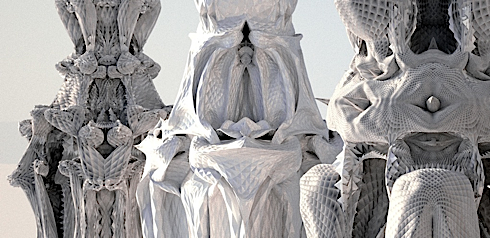Computational X
The best signpost to the future I know is to follow whatever happens after the word “computational.” For instance, to see where photography is going, follow the emerging field of computational photography. It is generating nine new ideas and products per day in imaging — from software that removes tourists from snapshots, to cameras that add makeup to portraits.
As the name implies, one applies fancy computers to traditional domains and sees what happens. So instead of using optical lenses in photography, you substitute algorithyms to create pictures with crude lenses, or with pin holes, or with no lenses. You replace film, lens, shutter, darkroom — either one at a time — or all together with computer cycles.
The same trick can be, and has been, done in the following traditional sciences. In fact these new fields are so established that there are journals and conferences dedicated to them.
Computational Biology
Computational Physics
Computational Chemistry
Computational Economics
Computational Medicine
But where the real frontier lies is on the computational edge of the softer sciences.
Computational Linguistics — Noticing the use of words by examining say the words in ALL the books ever written, previewed in Google Books, or to see how their use shifts in real time Twitter feeds. Or to compare all the words Milton used with all the words Chaucer used.
Computational Architecture — Inventing materials, forms, structures that cannot be made with concrete and glass. Generate endless varieties of one form, with ease. For some stunning examples see Michael Hansmeyer; one from his Columns series is below.

Computational Law — Processing evidence, dissecting and comparing law systems, testing arguments, extracting patterns.
The challenge here is not to replace X with AI, that is to replace a human with a robot. Computational photography is not replacing human photographers with robotic ones. Rather it is using computer chips to achieve photographic chores without materials like glass, and to do chores for us humans that no humans — or lenses and film — could do.
So the real excitement lies in imaging the least computerized field becoming computational. The possibilities are endless:
Computational Cuisine — Recombining ingredients for new dishes
Computational Music — Music generated by laws and principles of sales
Computational Real Estate — matching buyers and sellers and finance
Computational Laundry — Clothes tell the machines how to wash them
Computational Marketing — Exploring thousands of variables
Computational Nursing — Fully quantified patients with what-if models
Computational Driving — computer assisted auto and truck driving
Computational Construction — Modelling the work flow of projects
Computational Sketching — Fills in lines, remembers, offers 3d views
Computational Horticulture — Grafting, planting and growth scenarios
Computational Philosophy — Extracting logic from a complex argument
Computational Literature — Massive analysis of massive documents
Computational Politics — Complex adaptive models with forecasts
And why stop there?
Computational toys
Computational sleep
Computational grass mowing
Computational basketball
Computational design
Computational banking
Computational knitting
I have no idea what these would look like, only that considering the thought experiment would produce more than one viable idea.
Computational brainstorming, yes!!!!


